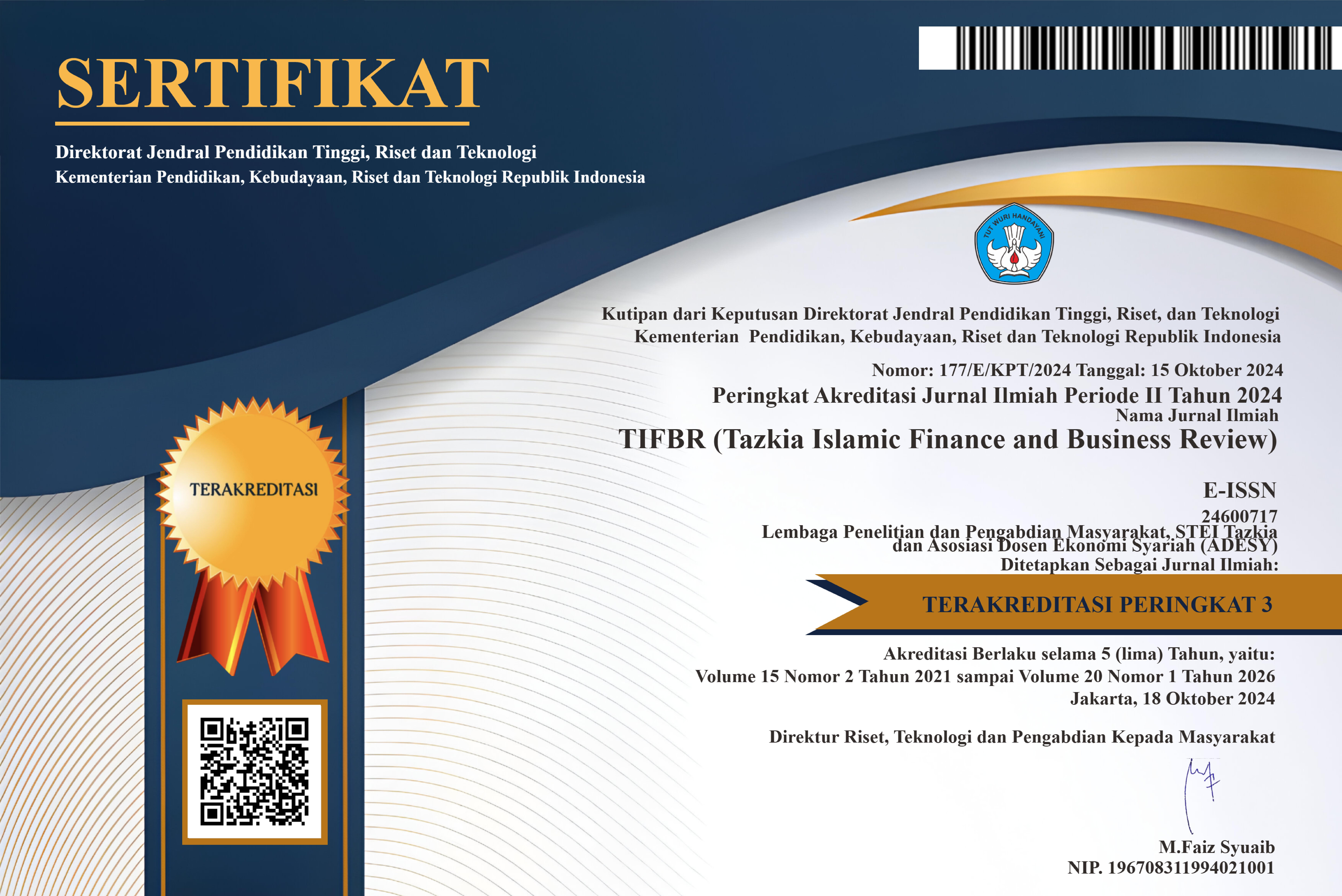Constructing an Islamic Socially Responsible Investment (SRI) Index; The Case of Indonesia
DOI:
https://doi.org/10.30993/tifbr.v11i2.141الكلمات المفتاحية:
Islamic finance، Socially Responsible Investments (SRI)، Capital markets، Stock Indexالملخص
The aim of this study are: (i) to develop an index based on Islamic stock from List of Islamic Securities (DES) and integrate them with the concept of Socially Responsible Investment (SRI) and (ii) to compare the performance of the constructed index with Jakarta Islamic Index (JII) and SRI Kehati Index. We construct the index using Equally Weighted Method from extensive dataset of more than 300 Islamic securities listed in the List of Islamic Securities (DES). Our result is fairly striking as the Islamic SRI index outperform JII and SRI Kehati as well. We conclude that additional screening with ESG parameter does not impact the index performance. To our knowledge, this research is the first to introduce an Islamic SRI stock Index, particularly in Indonesia. Hence, the result could be a consideration for the Indonesia stock exchange (IDX) stakeholder to introduce this index to the market. Furthermore, the results is expected to help investors in selecting stock that meet the standards of Islamic stocks while also fulfill the ESG criteria into their investment portfolios.
المراجع
Broby, D. and Morgan, L. (2013). What is the Appropriate Index Construction Methodology for African Equity Investment. The Capco Institute Journal of Financial Transformation.
Dow Jones Indices. (2016). Dow Jones Sustainability Indices Methodology.
Holland, J. (2011). A Conceptual Framework for Changes in Fund Management and Accountability Relative to ESG Issues. Journal of Sustainable Finance and Investment, Vol. 1 (2): 159-177
JSE Limited. (2014). SRI Index, Background and Criteria. JSE Limited.
Katsikas, E. and Czafrani, S. (2016). CSR Reporting Practices in Indonesia: A Case Study of Companies Listed on the SRI-Kehati Index. SSRN Paper.
Kehati. (2015). The List of Companies Entered into KEHATI SRI Index in 2009 – 2015.
Kurniasari, W., and Warastuti, Y. (2015). The Relationship Between CSR and Profitability to Firm Value in SRI Kehati Index. International Journal of Economic Behaviour, Vol. 5.
Marwan, S. and Ali, E. R. (2015). Sustainable and Responsible Investment; Trend and Prospect. Muzakarah Penasihat Syariah Kewangan Islam 2015.
Moghul, U. F. and Safar-Aly, S. H. K. (2014). Green Sukuk: The Introduction of Islam's Environmental Ethics to Contemporary Islamic Finance. The Georgetown International Environmental Law Review, Vol. 27(1).
MSCI. (2011). Intangible Value Assessment (IVA) Methodology. MSCI ESG Research.
MSCI. (2013). MSCI Global Socially Responsible Indexes Methodology.
MSCI ESG Research.
MSCI. (2016). MSCI ESG Governance Metrics. MSCI ESG Research.
Omar, E.N., Jaafar, H., and Osman, M. (2013) Halalan Toyyiban Supply Chain of the Food Industry. Journal of Emerging Economies and Islamic Research.
Pranata, N. and Nurzanah. (2015). Conventional and Islamic Indices in Indonesia: A Comparison on Performance, Volatility, and The Determinants. Indonesian Capital Market Review, Vol. 7 (2): 113-127.
Renneboog, L., Horst, J. T., and Zhang, C. (2008). Socially Responsible Investments: Institutional Aspects, Performance, and Investor Behavior. Journal of Banking and Finance, Vol. 32 (9): 1723-1742.
Schroder, M. (2005). Is there a Difference? The Performance Characteristics of SRI Equity Indexes. Discussion Paper No. 05-50, Centre for European Economic Research.
Sjöström, E. (2011). The Performance of Socially Responsible Investment - A Review of Scholarly Studies Published 2008-2010. SSRN Paper.
Tripathi, V. and Bandhari, V. (2014). Socially Responsible Investing; An Emerging Concept in Investment Management. FIIB Business Review, Vol. 3(4)
Trunow, N. and Linder, J. (2015). Perspectives on ESG Integration in Equity Investing: Risk-Adjusted Investment Performance. Calvert Investment Management Paper.
Zinkin, J. and William, G. (2006). Islam and CSR. A Study of the Compatibility between the Tenets of Islam and The UN Global Compact.
Zulkafli, A.H., Ahmad, Z., and Ermal, E. (2016). The Risk and Return
Profiles of SRI in Indonesia: A Study on SRI Kehati Index. Journal of Insurance and Financial Management, Vol. 2 (2): 1-17.
التنزيلات
منشور
كيفية الاقتباس
إصدار
القسم
الرخصة

Tazkia Islamic Finance and Business Review (TIFBR) is licensed under a Creative Commons Attribution-NonCommercial 4.0 International License.
Authors who publish with this journal agree to the following terms:
- Authors retain copyright and grant the journal right of first publication with the work simultaneously licensed under a Creative Commons Attribution License that allows others to share the work with an acknowledgment of the work's authorship and initial publication in this journal.
- Authors are able to enter into separate, additional contractual arrangements for the non-exclusive distribution of the journal's published version of the work (e.g., post it to an institutional repository or publish it in a book), with an acknowledgment of its initial publication in this journal.
- Authors are permitted and encouraged to post their work online (e.g., in institutional repositories or on their website), as it can lead to productive exchanges, as well as earlier and greater citation of published work (See the Effect of Open Access).
















